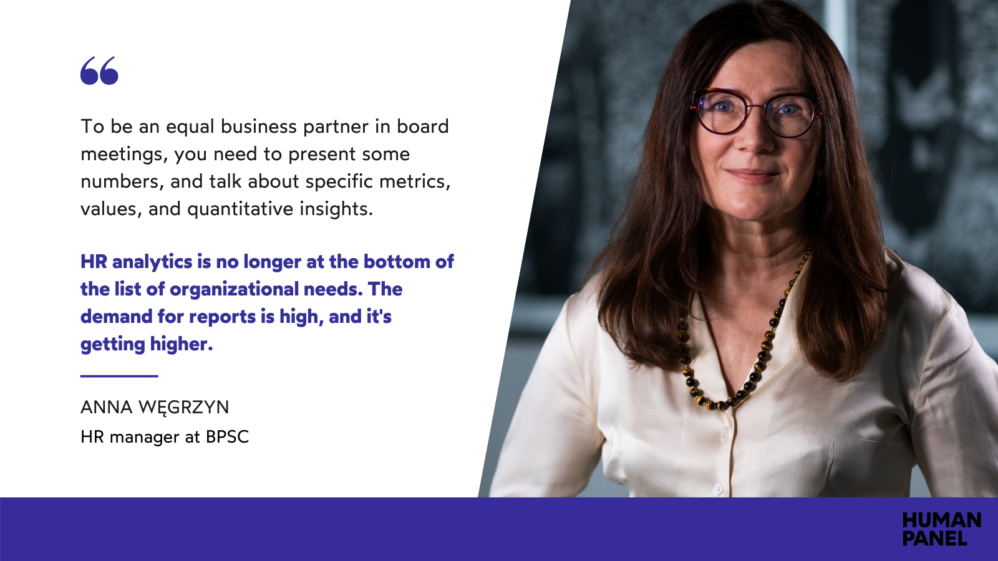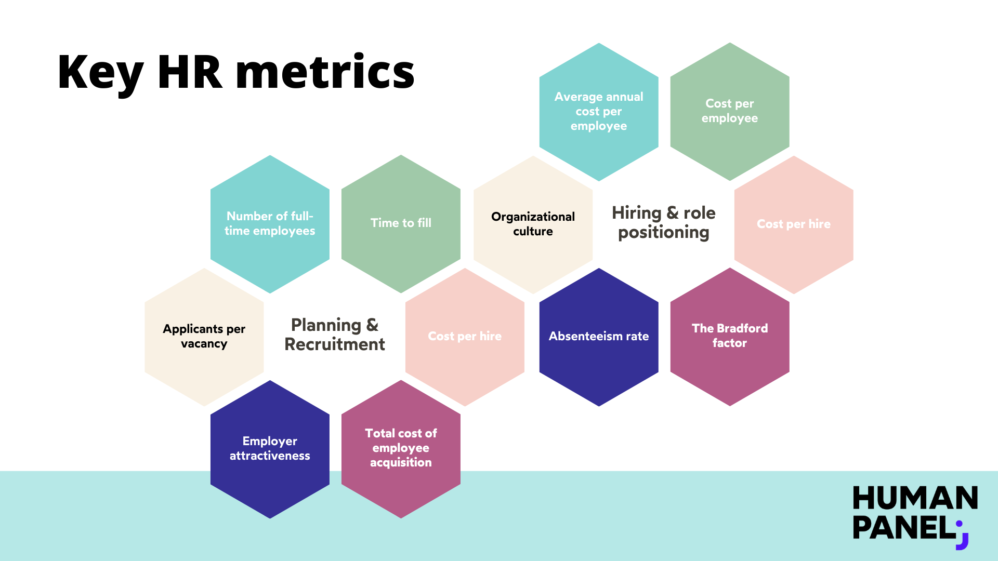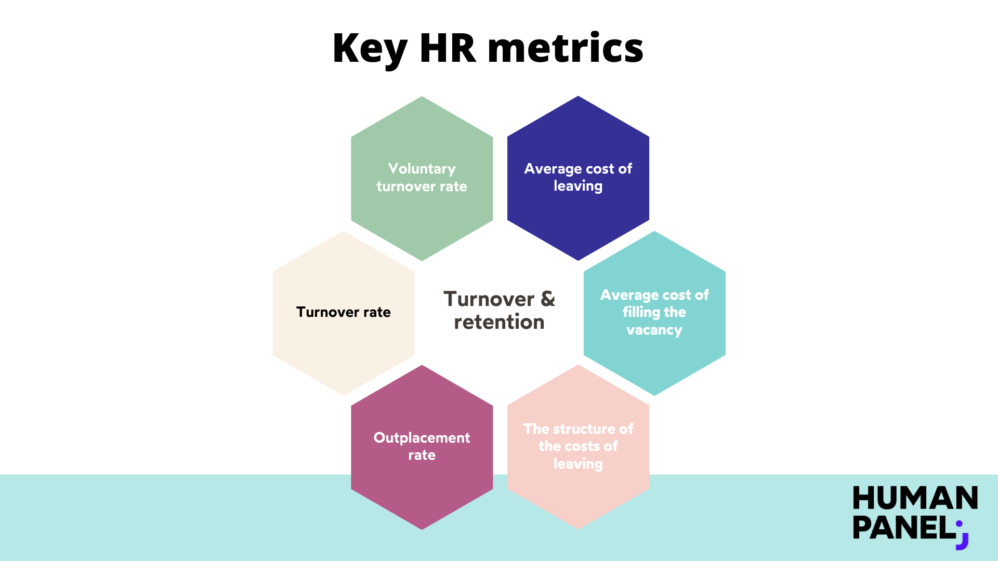A walk through key HR metrics with BPSC

Together with Anna Węgrzyn, Human Resources Manager at BPSC, we take a look at the key HR metrics worth tracking throughout an employee’s organizational lifecycle.
When starting their journey with people analytics, many HR leaders wonder what the key HR metrics are that they should track. Where should they look, what should they measure, and how should they translate the results into action? Today, we will talk about this with Anna Węgrzyn, HR manager at BPSC, a company that specializes in enterprise resource planning. The company’s flagship product is the Impuls EVO ERP system, which is used by over 700 companies in Poland.
Anna Węgrzyn has over 30 years HR experience in a range of industries and organizations. She has a passion for people analysis and gives lectures at the most famous Polish universities.
She shared her knowledge with Human Panel and explained why it is important to look at different HR metrics throughout the lifecycle of an employee in a company.
“HR Analytics is no longer at the bottom of the list”
“Human capital is something extraordinary in today’s job market. It is what can help outperform the competition. However, we should not forget that companies do not own people. Employees are not their companies’ property. That’s why it’s so important to raise managers’ awareness of human resource management.
To be an equal business partner in board meetings, you need to present some numbers, and talk about specific metrics, values, and quantitative insights. This can also be valuable information for stakeholders, investors and owners – if they are to invest in a particular company, they need to know what workforce they are getting with the company.

HR analytics is no longer at the bottom of the list of organizational needs. The demand for reports is high, and it’s getting higher. Employers want to know how much they will have to pay for a good employee, and how long their training will take. All of this is needed to manage headcount effectively: to know where to hire, how much to pay, or where to cut back. This way, you can make employees the company’s greatest asset and turn their value into the company’s business value,” says Anna Węgrzyn.
The key HR metrics according to Anna Węgrzyn:
Planning
Number of full-time employees: average number of employees with a permanent full-time employment contract / the average total number of employees (total number of persons including full-time, part-time, temporary and contract workers).
Tracking the number of full-time employees shows how many employees are embedded with the employer and gives you an overall impression of your ability to attract and retain a diverse workforce.
Applicants per vacancy (applicants per hire): number of total applications in a given period / number of vacancies in a given period.
This metric allows us to track employee attraction and employer branding success. It is an indicator of your efforts in personnel marketing.
Recruitment
Time to fill: the average time it takes to find, recruit, hire, and onboard an employee. It is usually expressed in days that elapse between the posting of a job opening and the day your new hire becomes a fully fledged employee.
This metric shows you how long your recruitment and onboarding processes take.
Cost per hire: average cost of hiring an employee.
Total cost of employee acquisition: cost of recruitment / cost of candidate selection / cost of onboarding and matching new employees.

Hiring and role positioning
Organizational culture: employees’ assessment of relevant elements of organizational culture.
Average annual cost per employee:total employment cost / average total number of employees.
Cost per employee
Cost of employee absence
Absenteeism rate in terms of: position, team, time (short and long term absences).
The Bradford factor
The Bradford Factor is used to measure your employees’ absenteeism, focusing on frequent and short-term absences.

Evaluation and motivation
Competency assessment:number of employees whose competencies meet the requirements of a particular job / total number of employees.
Employee appraisal:The average employee appraisal score over a given period of time.
Employee satisfaction and engagement
Interpersonal relations
Compensation raises and promotions
Benefit costs per employee
Average compensation relative to market benchmarks
Cost of HR in relation to total costs
Learning and development
Costs of training and development
Cost of investment in employees: Cost of training and development per employee / average remuneration in the company.
Effectiveness of training
Competence fit
Knowledge exchange
Career paths: How many jobs have a defined career path?
Individual development plans: How many jobs have an individual career path?
Coaching and mentoring: How many employees have access to coaching and mentoring?
Promotion rate: The number of employees promoted / Total number of employees.
Internal promotion rate

Staff turnover and retention
Voluntary turnover rate: number of employees who leave the company voluntarily / total number of employees
Turnover rate: number of employees who leave the company, regardless of the reason / the total number of employees
Outplacement rate
Average cost of leaving
Average cost of filling the vacancy
The structure of the costs of leaving
How to determine key HR metrics?
Anna Węgrzyn emphasizes that it is usually not necessary to measure everything. “Focus on a few relevant metrics rather than trying to measure everything,” she says.
Is there an HR metric she’s missing that she’d like to have? “I think we could capture the moment better when an employee’s satisfaction starts to drop. It’s related to measuring employee well-being and overall satisfaction. It would help us detect the first symptoms of burnout and declining motivation,” adds Anna Węgrzyn.
If you want to start measuring employee satisfaction and other HR metrics, Human Panel will help you set up an effective HR management system. If you are curious about how it works, schedule a demo and see People Analytics in action.




